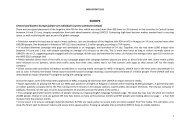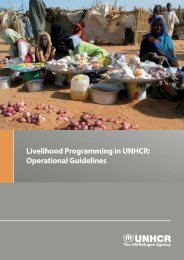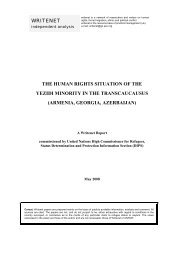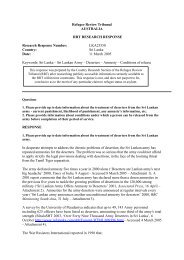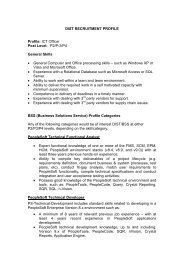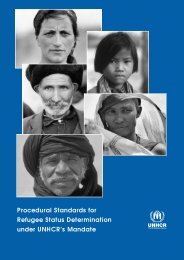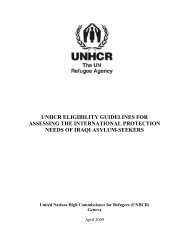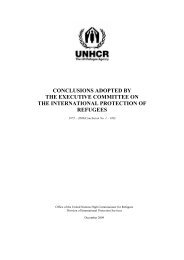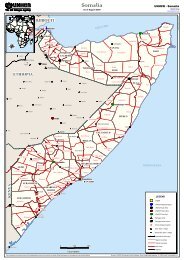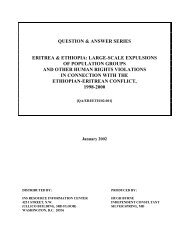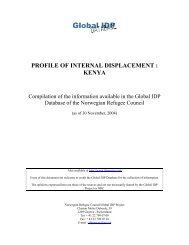UNHCR's ELIGIBILITY GUIDELINES FOR ASSESSING THE ...
UNHCR's ELIGIBILITY GUIDELINES FOR ASSESSING THE ...
UNHCR's ELIGIBILITY GUIDELINES FOR ASSESSING THE ...
You also want an ePaper? Increase the reach of your titles
YUMPU automatically turns print PDFs into web optimized ePapers that Google loves.
violence and have been subject to regular attacks since 2003. 223 The Brookings Institution/<br />
University of Bern Project on Internal Displacement cited an Iraqi observer saying that the<br />
broader problem of sectarian violence in Iraq was not only an issue between the country’s<br />
Shi’a and Sunni communities, “but rather an organized effort to target all “other”<br />
communities”. 224 Largely without protection on the basis of tribe, militia or political<br />
party, 225 and often perceived as relatively wealthy, non-Muslim minorities are particularly<br />
vulnerable to attacks for perceived threat to the Islamic nature of the state, imputed<br />
affiliation with international actors, break-down of law and order, and general criminality.<br />
There is undoubtedly a strong subjective fear among religious communities in Iraq that<br />
their very existence is at stake. 226<br />
Members of non-Muslim religious minorities have become regular victims of<br />
discrimination, harassment and serious human rights violations, with incidents ranging<br />
from intimidation and threats to the destruction of property, kidnapping, 227 rape, forced<br />
conversion and murder. Along with the deterioration of the situation for Iraqi women in<br />
general due to the strict embracing of Islamic values and traditions as well as the high rate<br />
of criminality, women belonging to religious minority groups are often forced to comply<br />
with strict Islamic dress codes. 228 Their freedom of movement is also restricted due to the<br />
threat of kidnapping and rape. 229<br />
223 UNAMI HRO reported that “(W)hile the initial violence randomly targeted the Arab Sunni community,<br />
allegedly for their unproven association with the destruction of Al Askari Shrine, members of all communities<br />
were negatively affected by the unleashed violence and tit-for-tat attacks”; see UNAMI HRO, February 2006<br />
Human Rights Report, p. 2, see above footnote 165. See also: USCIRF, Iraq: USCIRF Letter to Under<br />
Secretary of State Dobriansky Urges Refugee Protections for Iraqi Religious Minorities, 9 November 2006,<br />
http://www.uscirf.gov/mediaroom/press/2006/november/20061109IraqRefugees.html.<br />
224 Al-Khalidi and Tanner, p. 24-25, see above footnote 161.<br />
225 Christians currently have the following representation in the central government: Wijdan Mikha’il, a town<br />
planner and member of the secular Iraqi National List, is the Minister of Human Rights; Yonadem Kanna of<br />
the Assyrian Democratic Movement is a member of the Council of Representatives.<br />
226 UNAMI HRO indicated that “Sabean-Mandeans continue to be targeted by extremists and their<br />
continuous presence in the country is endangered”; see UNAMI HRO, October 2006 Human Rights Report,<br />
p. 3, see above footnote 66. In an earlier report it said: “Members of Iraqi ethnic, religious or linguistic<br />
minorities feel that their identity and even physical existence is threatened”; see UNAMI HRO, August 2006<br />
Human Rights Report, p. 2 and 13, see above footnote 26.<br />
227 According to UNAMI HRO, “(K)idnappings by criminal gangs have revealed a sectarian dimension”;<br />
see UNAMI HRO, August 2006 Human Rights Report, p. 2 and 8, see above footnote 26.<br />
228 Strict Islamic dress codes includes the requirement that women wear an abaya, a traditional full-length<br />
cloak and a headscarf; see: IRIN, Iraq: Christians live in fear of death squads, 19 October 2006,<br />
http://www.irinnews.org/report.aspx?reportid=61897. According to the USDOS, Basrah’s Education Director<br />
introduced a rule requiring all females in the schools to cover their hair. The same report states that female<br />
university students in Mosul, even non-Muslims, were required to wear the hijab; see: USDOS, International<br />
Religious Freedom Report 2006 – Iraq, see above footnote 28. UNAMI HRO reported that “(I)ndividuals<br />
continue to face harassment and intimidation by extremist elements if they are not inclined to conform to<br />
traditional dressing. Women, national and religious minorities as well as homosexual were particularly<br />
targeted”; see UNAMI HRO, June 2006 Human Rights Report, p. 8-10, see above footnote 27. See also<br />
“Persons Accused of “Un-Islamic” Behaviour”.<br />
229 UNAMI HRO, August 2006 Human Rights Report, p. 10, see above footnote 26.<br />
58




